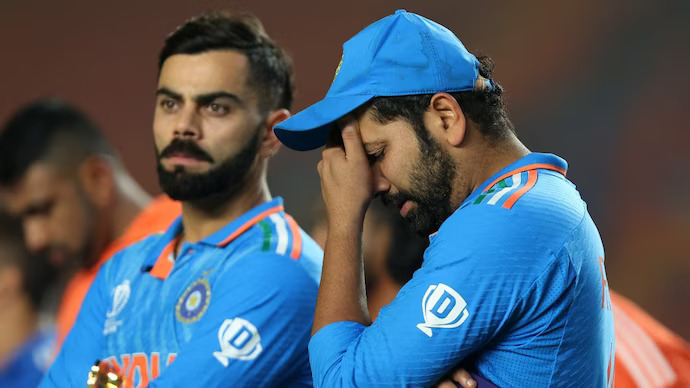
As the cricketing world stood in collective disbelief witnessing India’s unexpected defeat in the World Cup, In this comprehensive blog post, we will delve into the key points analyzing the unorthodox rotation of bowlers, the surprising absence of strategic communication from the coaching staff, and the notable contrast in approaches between the semifinal and the final. Join us on this cricketing journey as we actively dissect these aspects to gain a deeper understanding of India’s performance and the missed opportunities that led to their defeat.
Unconventional Bowling Rotation: A Double-Edged Sword
The blog post kicks off by shedding light on an intriguing aspect of India’s bowling strategy in the final – the rotation of bowlers Shami and Bumrah during the first 10 overs. While the early success in scalping three wickets is acknowledged, the question still persists of the wisdom of applying too much pressure in the initial phase. The analogy of not riding all your bikes simultaneously is invoked to underscore the potential downside of this approach. Let’s delve into the nuances of this strategy and its impact on the game.
Analyzing Typical Bowling Strategies:
To comprehend the significance of the unconventional rotation, it’s essential to first understand the typical strategies teams employ during the powerplay overs. The powerplay is traditionally a time for aggressive bowling, aiming to take early wickets and put the opposition on the back foot. By rotating Shami and Bumrah, Rohit Sharma departed from the norm, as this brought a sense of caution in the approach of the Australian Batters because this move from the Indian skipper sent a message to the Aussies of how attacking India is trying to be early on in the chase. This also gives a slight intuition of the nervousness Indian bowling is in due to playing only 5 main bowlers.
Impact on Australian Batsmen’s Mindset:
This strategy allowed the Australian batters to adapt with composure as the game progressed. We delve into how this adaptation unfolded and its consequences on the momentum of the match. Did the Australian batsmen seize the opportunity to settle in and counter-attack later in the innings? Yes!! this is exactly what they did as the evolution of their approach becomes a critical focal point of this analysis. To give context to this point, India had scored 131/3 in 25 overs and Australia had scored 135/3 in the same 25 overs.

Comparing Rohit Sharma’s Tactics:
To contextualize this move, we compare Rohit Sharma’s tactics in the final with those employed throughout the tournament. Was this rotation a one-off decision, or did it align with a broader strategy? Understanding the captain’s mindset and decision-making process becomes crucial in evaluating the overall effectiveness of this move. On one hand, Skipper Rohit played his triumph card the premuim fast bowlers Shami and Bumrah but on the other Hand the field wasn’t in sync to their bowling. To give context to this point, Both Marnus Labuschangne and Travis Head had problems initially in playing Shami and Bumrah. They hardly timed the ball to perfection and hung on the crease to set themselves to counter Attack. Both the aussies batter edged numerous balls to spinners and the fast bowlers which resulted in undue boundaries in the third-man region in absence of a Slip Fielder. This again showed Rohit Sharma’s Defensive approach in field with Attacking bowling resulting in leaking Runs.
Strategic Silence from the Dressing Room: A Missing Link in Communication
The reflection transitions to the second point of concern – the apparent lack of communication from the coaching staff during the game. The absence of perspectives or messages from the head coach or senior coaches during crucial moments is highlighted as this wasn’t seen earlier in the league stage matches and the semis against New Zealand. A departure from the norm observed throughout the tournament.

Role of Coaching Staff During Crunch moments in Matches:
Coaches are often seen as the strategists behind the scenes, guiding the team through critical moments. The blog post explores the typical role of coaching staff during matches, especially in high-stakes situations like a World Cup final. What expectations do players have from their coaches during such moments, and how does their guidance influence on-field decisions?
Impact of Communication Breakdown:
The absence of communication is discussed in terms of its impact on player morale and decision-making. Did the lack of strategic input from the coaching staff contribute to a sense of uncertainty on the field? How did the players respond to this silence, and did it reflect in their performance? It only resulted in India losing out the match to Australia not because of Skill and cricketing prowess, but due to Mental Choking and lack of proper conducting during emotionally high moments such as celebration on a wicket of Australia.
Positive Instances of Coaching Staff Involvement:
To provide a balanced perspective, the blog post highlights instances from the tournament where coaching staff involvement positively influenced the team’s performance. By juxtaposing these instances with the silence observed in the final, readers gain insights into the potential consequences of the coaching staff’s non-involvement.
Comparing Semifinal and Final Performances: A Tale of Two Matches
The third section of the reflection draws a stark comparison between India’s performance in the semifinal against New Zealand and the final against Australia. The exemplary conduct in the semis, where they played almost one-sided cricket, is contrasted with the seemingly erratic behavior in the final. This section is about the psychological aspects of maintaining composure in high-pressure situations.
Contrasting Demeanor:
Analyzing the stark contrast in India’s demeanor in the semifinal and final matches becomes crucial to understanding the team’s mindset. Did the elation of reaching the final lead to a lapse in focus and composure? How did the players’ conduct on the field differ between these two crucial matches?
Psychological Impact of Player Conduct:
The psychological aspect of maintaining composure in high-pressure situations is explored in-depth. How the behavior of players on the field influence their performances was something we could see in the indian fielding in 2nd innings.
Learnings from Success and Failure:
To provide a broader perspective, the post reflects on the importance of learning from both victories and defeats. What lessons can be gleaned from India’s success in the semifinal, and how can these lessons be applied to future tournaments? The reflective nature of this section invites readers to consider the long-term implications of the team’s conduct in high-stakes matches.
Pressure is something which will always be there considering the fanbase of indian cricket team. Every player coming into the team was able to perform to his full potential just because they never ever took this burden of expectations of a billion people on their shoulders which in combination with the skill and cricketing prowess resulted in 10 wins and remaining unbeaten until the finals. This is what the players should always focus on and not go into the big finals with extra baggage and remember why were tey able to qualify for the finals. A reflection of those before going into the knockouts and finals will always clear the heads of each individual and they will realize that it is the same things which needs to be done to get over the line with a victory.
Australia’s Mind Game: Playing Chess on the Cricket Field

The final section of the reflection turns the spotlight on Australia’s strategic approach. The post suggests that Australia entered the match with a clear understanding of external factors, such as the overwhelming crowd support for India and the pressure of being an unbeaten team in the tournament. This section analyzes how Australia’s strategic mindset influenced their performance and played a significant role in their victory.
Handling External Pressures:
Australia’s strategic approach to handling external pressures is dissected to understand how they turned potential challenges into advantages. Did the team enter the match with a well-thought-out plan to capitalize on the expectations placed on India? Yes they certainly did that. Australia’s Strategic Approach was evident right from the beginning of the match. They seamlessly put pressure on Indian Batting with their fielding and probably saved 30-40 runs just by diving near the boundary line quite often during the Indian batting.
Psychological Impact of Home Crowd Support:
The psychological impact of playing against a home team with massive support is explored. How did Australia leverage the overwhelming crowd support for India to their advantage? The post delves into the intricacies of the mental game played on the field and the role of crowd dynamics in shaping the outcome of the match. The Crowd which always is a support system to the Indian players, but this time Indian players abruptly made it a source of pressure for themselves. Where as Australia may have sensed that the indian side will be under pressure as this support from the crowd is a double edged sword which either pumps up the player or they scumb to the pressure of so many expectations.
From an Australian side outlook they basically had no pressure as they were playing away from the home crowd and given the stature and image that the opposition carried they basically had a underdog mindset so they could express themselves completely through their Fielding, Batting and Bowling. This free mindset allowed them to completely focus and become one-pointed, as a result of one-pointedness and the high caliber cricketing skills Australia possesses they comfortably won the match and the world cup with 7 overs to spare.
Test Cricket Mindset in Limited Overs:
A unique aspect of Australia’s approach is highlighted – their adoption of a test cricket mindset in a limited-overs format. The strategic decision to focus on staying on the wicket rather than playing aggressive shots is scrutinized for its impact on the game. This mindset basically was very much visible when Australia Lost 3 wickets in first 7 overs at a score of 47 runs. Marnus Labuschagne and Travis Head hung on the crease while they were very unsettled in the beginning. Both of them struck the ball at a strike rate of 52.7 and 114.1 respectively. That shows how cautious they were in there run chase. They did have a few problems early on and throughout the innings as they were constantly mistiming and edging the ball throughout their innings.
Conclusion: Lessons Learned and Future Horizons
In conclusion, this blog post has provided a comprehensive analysis of the factors contributing to India’s loss in the World Cup final. From the unorthodox rotation of bowlers to the lack of strategic communication from the coaching staff, and the contrasting conduct between the semifinal and final matches, each aspect has been dissected in detail. The post has also shed light on Australia’s strategic mindset and how they played the mental game to their advantage
.Cricket enthusiasts and analysts like can draw valuable lessons from this reflective exploration. The intricate dynamics of the game, encompassing strategic decisions, communication nuances, player conduct, and opposition mindset, offer a wealth of insights for future tournaments. As the cricketing world reflects on India’s World Cup journey, the focus shifts to learning from both successes and defeats, ensuring that these lessons shape a more resilient and strategic team in the future.



